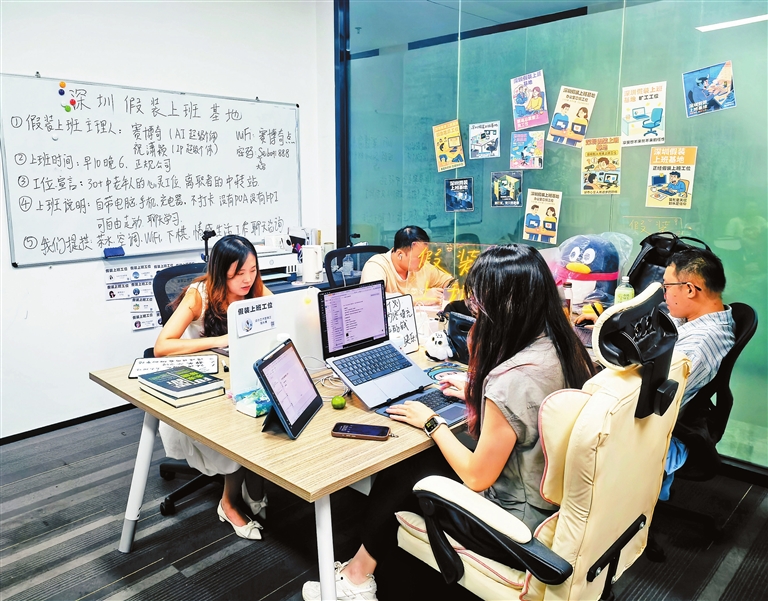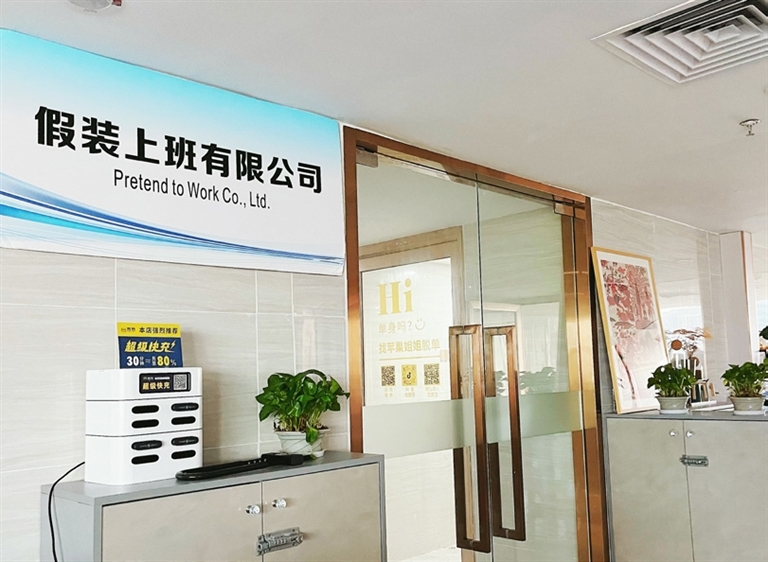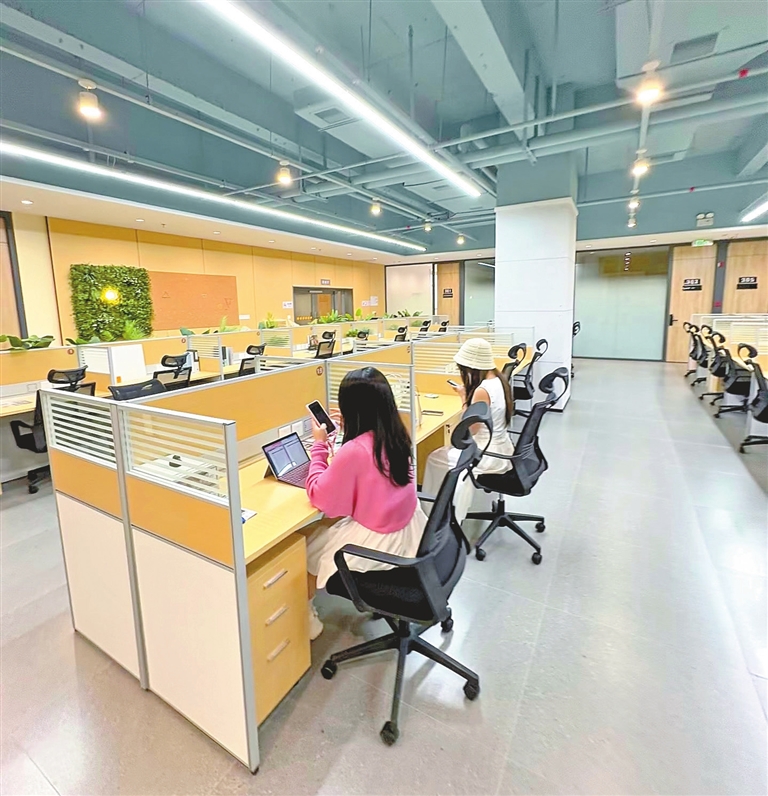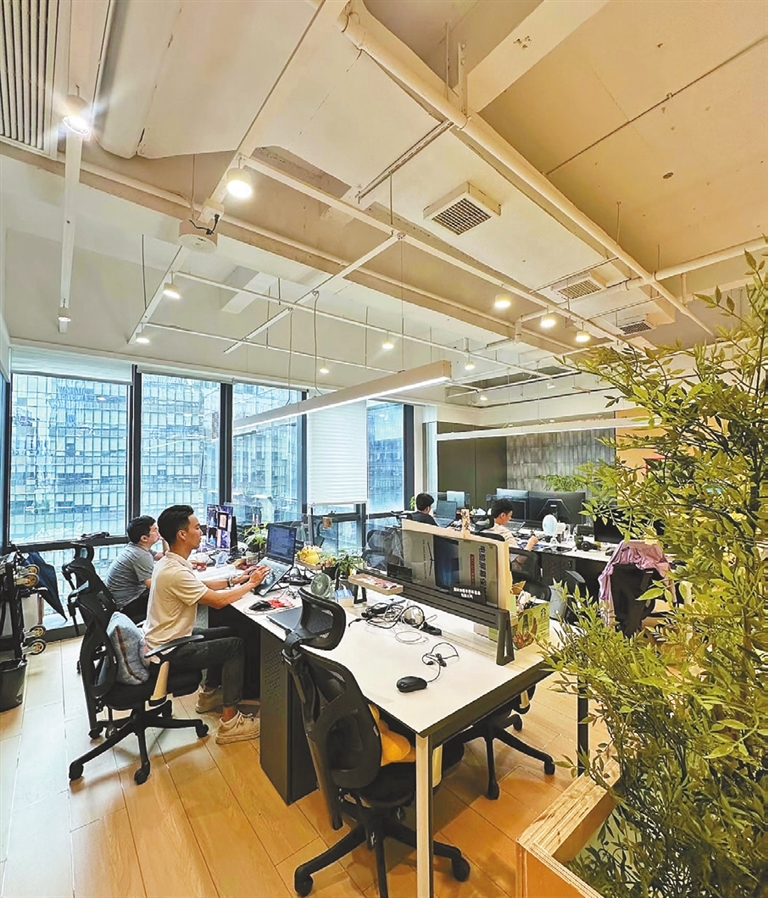




Wei Jie claudiamente@hotmail.com IN the Chinese TV series “A Little Reunion,” released in the summer of 2019, middle-aged father Fang Yuan pretended to go to work every day after being laid off. Lately, a similar scenario has been playing out in real life with the emergence of so-called “pretend-to-work” companies in Shenzhen and other Chinese cities — people are actually paying to simulate a day at the office. Variant of the shared-office economy Unlike Fang, who idled away office hours in air-conditioned supermarkets or shopping malls, those who use these services do go to a real workspace. They upload basic profiles or “resumes” online, make reservations on the days they plan to show up, and pay a daily fee to use a desk and chair. Once there, they spend the day creating the appearance of being at work — opening a laptop, sitting at a desk, and following a routine that looks like a typical 9-to-5. The so-called “pretend-to-work” model is essentially a form of the shared-office economy, where people rent office space and related amenities for short periods. What sets it apart from genuine employment is that these setups impose no corporate KPIs, no manipulative management practices (often referred to as “PUA”), and involve no performance-driven competition or vested interests. For many users, the service is less about productivity and more about reclaiming social standing, routine, and a sense of normalcy. High demand These operations offer no salary, no title, and no path to promotion. Just an empty desk, a laptop, and the illusion of a 9-to-5. Yet demand has been strong. People do pay to go to a job that doesn’t exist every day. In May this year, Liu Guanjie opened a “pretend-to-work” company in Qinghu, Longhua District. The nearly 100-square-meter office houses about 20 work desks and charges 30 yuan (US$4.23) per person per day. In the first month of the business, Liu’s company received more than 200 “employees,” and its desks were almost full every day. A similar “pretend-to-work” service is also available in Bao’an District, where more than 400 people have either checked in to “work” or are on the waiting list since its founder Sai Boqi (a pseudonym name) launched the service at the Bao’an E-commerce Science and Technology Park in Bao’an District in July. Sai offers only six bookable seats each day at 60 yuan per person. A search for “pretend to work” on Xiaohongshu, or RedNote, China’s answer to Instagram, showed that these setups have sprung up in nearly every district in Shenzhen. Many users leave comments under these posts, asking for exact addresses and booking details. In a society where job status often defines identity, these places offer a pragmatic — if unconventional — workaround for people stuck in career limbo. Emotional solace Yu Zhuo ran a restaurant in Bao’an District before his business collapsed earlier this year. Unemployed and demotivated, he struggled with the quiet disapproval of family and the weight of social pressure. Last month, he stumbled on Sai’s “pretend-to-work” service on Xiaohongshu. For 60 yuan a day, he commutes to Sai’s shared office and sits alongside five others in similar circumstances, reclaiming the daily routine of being part of the working world. He usually arrives at the office around 9 a.m. and sometimes stays until 10 p.m., lingering until everybody leaves so it looks convincing. “I kind of feel happy,” he said. “It’s like we’re working together as a group.” He even sent photos of the office to his parents, who, he said, appeared more at ease now seeing him in a professional setting. The space has also become more than a façade. It’s a refuge where Yu chats with his “colleagues,” shares meals, and sometimes plays games. Recently, he’s been teaching himself AI tools he’s seen listed in real job ads, studying tutorials on his laptop between coffee breaks. “It’ll make it easier to get hired,” he said. “This place gives me a reason to keep going.” The combination of social support and practical self-improvement has helped him regain momentum. For others, the community aspect is equally transformative. At Sai’s space, Yang Yifu recently swapped an old desk sign that read “Yang Yifu with nothing to do” for a new one declaring “Confident, energetic Yang Yifu.” He now runs a cross-border e-commerce startup while preparing to take exams to upgrade his academic qualifications. When he first came, Yang was downcast from life setbacks and embarrassed about not having a university degree. Through the “pretend-to-work” routine, he made friends, found encouragement, and gradually rebuilt his confidence. “People here told me not to belittle myself. I was reminded that if I commit to what interests me, respect will follow.” He credited the co-founder of Sai’s “pretend-to-work” office with sharing her own stories of daring attempts that inspired him to try again. “I come here every week. It’s not so much about working as about finding myself.” Yang’s sentiment was echoed by several others, who said the space gave them structure, support, and a softer path back into workforce. Social networking function Apart from unemployed people like Yu who use the routine to ease their families’ worries, pretending to work has given some participants a real sense of purpose. Some use the time to network or polish their resumes. Hao Yutong was a UI (user interface) designer in Pingshan District before leaving that job to run her own studio. Every week, she will drive for more than one hour to “go to work” at Sai’s space. On her first visit, she connected with Ding Xi within one hour. After chatting, the two agreed to team up on projects. “She’s got tech skills, and I do the design. This is a precise and efficient match,” said Hao. Ding also left a large internet company to start her own business. Sai’s partner, Zhu Xiaoying, left a large tech firm to run a media startup. At their “pretend-to-work” space, Zhu has hosted several sessions sharing experiences on AI projects and IP incubation, attracting many corporate employees and professionals from different industries to network and spark ideas. “When you feel lost, you can come here and find new direction,” she said. Bridge to real opportunity Even though Liu’s space is popular — the 20 daily openings his setup offers are almost fully taken — his venture is still losing money. Charging 30 yuan per person per day doesn’t really cover the monthly costs of approximately 9,000 yuan. “I knew from the beginning that I can’t really make money from this,” said Liu, who mainly supports himself through his e-commerce business. “I didn’t open this ‘pretend-to-work’ company to make money.” The idea of this “pretend-to-work” company came together in less than a month, but Liu said the concept had been brewing for years. While preparing for civil service exams a few years back, and later during his entrepreneurial efforts, he often bounced between libraries and cafes across Shenzhen. He noticed two groups of people that needed a transitional space between home and work. The first is unemployed people who want to avoid worrying their parents with their struggles and maintain the appearance of going to work.。 The second is freelancers, such as digital nomads, e-commerce sellers, and online writers, who crave structure and community. “Many people come here to find identity, relieve anxiety, regain confidence, or improve themselves,” Liu said. Zhou Mi, who operates a “pretend-to-work” space on Hongling Road Central in Luohu District, said more than 60% of his customers are unemployed people or recent graduates. He sees his business as more than a rental service. “I’m not selling workstations,” he said. “I’m selling the dignity of not being viewed as a useless person.” He watches customers arrive, settle into a routine, and leave with a little more steadiness in their step, and he believes that small restoration of pride is part of what his business provides. Zhou also has doubt about the model’s long-term commercial viability. “Long-term profitability? I doubt it,” he acknowledged. “But if we can help someone turn this fake office into a real starting point, then the experiment has value.” For him, the measure of success isn’t sustained revenue so much as whether the space can act as a bridge toward genuine employment or renewed confidence. The bridge is already forming for some users. Mai Jianzhou, a recent graduate from neighboring Guangzhou, often shows up at Sai’s “pretend-to-work” studio and has used the time to sharpen marketable skills rather than merely simulate a workday. He spends much of his day learning AI tools, building a portfolio, and applying to real jobs. The pretend office has become an interim platform for development rather than an end in itself. “I don’t want to pretend forever,” Mai said. “But for now, this is how I keep going.” Whether these shared façades will evolve into lasting stepping stones for meaningful careers remains uncertain, but for users they provide routine, peer support, and a practical space to prepare for the next real opportunity. | 
